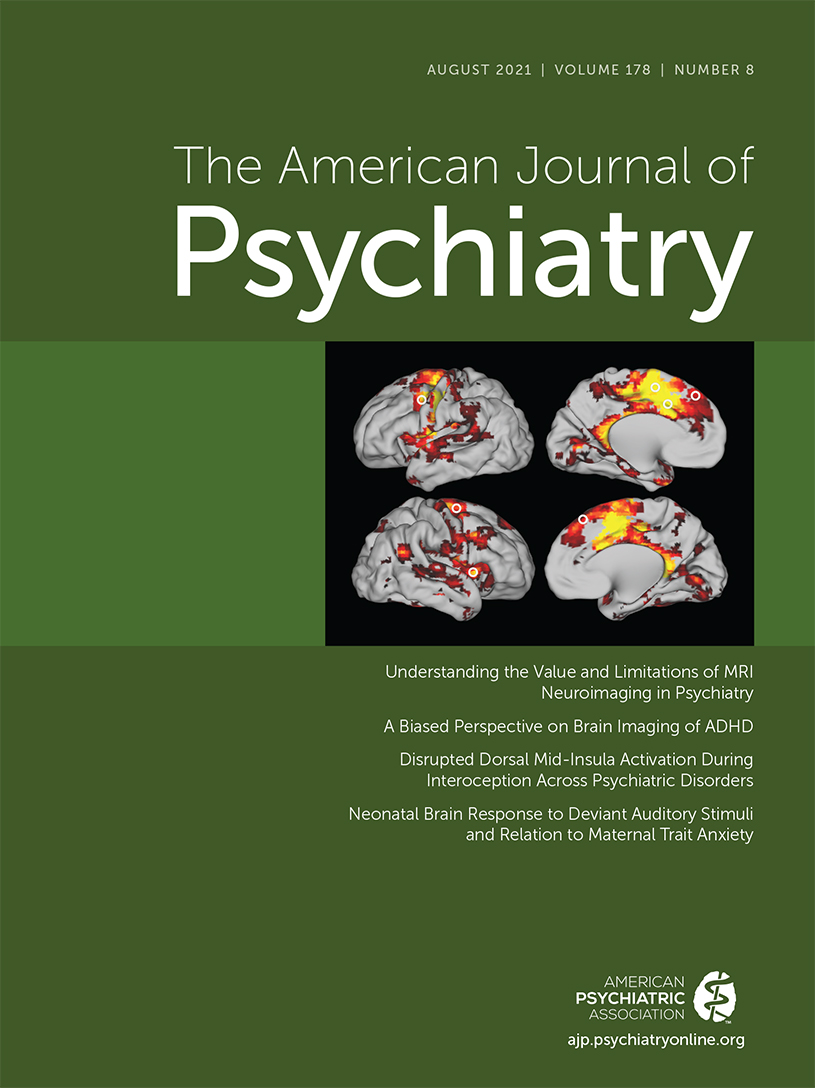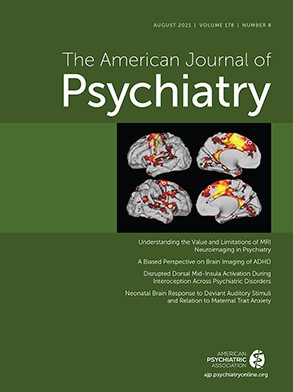Pharmacotherapy is an important component of the multimodal treatment of attention deficit hyperactivity disorder (ADHD). Medications approved by the U.S. Food and Drug Administration for ADHD include stimulants (methylphenidate and amphetamines) and nonstimulants (atomoxetine, extended-release guanfacine, extended-release clonidine, and viloxazine) (
1). In clinical guidelines (
1), stimulants are generally recommended as the first-line pharmacologic option, with some guidelines (e.g., those from the National Institute for Health and Care Excellence [
2]) further recommending methylphenidate over amphetamines as the first-line stimulant in children, given its more favorable acceptability and tolerability profile. These recommendations are in line with meta-analytic evidence from randomized controlled trials showing that, at the group level, effect sizes of stimulants are generally higher than those of nonstimulants in terms of reduction of severity of ADHD core symptoms (
3). However, there is variability in response at the individual patient level. In crossover randomized controlled trials, around 41% of participants responded to both amphetamines and methylphenidate, 28% responded better to amphetamines, 16% responded better to methylphenidate, and 15% did not respond to either of the two stimulants (
4). Unfortunately, to date there are no reliable predictors of response, so the choice of medication in clinical practice is based on a trial-and-error process. Some in the field hope that this gap will be filled by the emerging approach of precision psychiatry, which, influenced by the broader concept of precision medicine, aims to develop and implement models that are able to accurately predict the diagnosis of psychiatric disorders, their prognosis, or the response to treatments at the individual patient level (
5).
In this issue of the
Journal, Norman et al. (
6) report the results of a longitudinal study assessing the association between resting-state functional MRI (fMRI) connectivity and response to stimulants. The study included a sample of 110 children with ADHD treated with stimulants, who, alongside a typically developing control group (N=142) underwent scanning up to five times during development (ages 6–17 years). Worse response to stimulants was significantly associated with an atypical increase in cingulo-opercular resting-state connectivity with increasing age. By contrast, better response to treatment was significantly associated with stability of cingulo-opercular connectivity over the developmental period, which was similar to the connectivity observed in the control group. In a sensitivity analysis, the findings were not significantly different by type of stimulant (methylphenidate-based or amphetamine-based agents). The study results are plausible, considering that in randomized controlled trials in patients with ADHD, acute doses of stimulants during cognitive tasks have been shown to normalize the functional activity of brain areas overlapping with the cingulo-opercular network (
7). Furthermore, functional abnormalities in the cingulo-opercular network have also been reported at rest, albeit inconsistently, in individuals with ADHD (
8). The authors hypothesized that stimulants may normalize activity in cingulo-opercular regions during cognitive tasks only when resting-state connectivity is close to typical levels. Alternatively, stimulants might lead to “better than typical” cingulo-opercular connectivity, which would contribute to compensation of ADHD symptoms.
Do the findings of this elegant study mean that we now have a predictor of response to stimulants? Are we ready to move from the present-day approach to the future (
Box 1)? Unfortunately, the answer is no. Why? Norman and colleagues’ study is highly valuable, as it advances our knowledge on the pathophysiological mechanisms underlying response to stimulants, pointing to the cingulo-opercular network as a possible target of novel treatments. However, it was not designed to provide the level of evidence required to support the use of cingulo-opercular connectivity as a predictor of response in clinical practice. Indeed, the science of prediction, which informs precision medicine, has established a series of rigorous procedures that need to be addressed before prediction models can be implemented in clinical practice (
5).
First, it is recommended that predictors be selected on the basis of the highest level of evidence. Although plausible from a neurobiological standpoint, the role of atypical cingulo-opercular connectivity will need to be replicated in independent studies and, preferably, confirmed by meta-analyses. Second, the massive multivariate and multimodal nature of mental health conditions points to the need to include multiple predictors, rather than relying on one predictor only. Of note, a study testing a set of possible predictors of response to methylphenidate in ADHD (including demographic, clinical, genetic, and resting-state fMRI measures) provided an accuracy of 84.6%, with age, weight, MspI and DraI polymorphisms in the alpha-2A adrenergic receptor gene, lead level, Stroop color and word test performance, and oppositional symptoms as the most differentiating predictors (
9). However, a systematic review of prediction models in psychiatry (
10) found that most available models (69.5%) were based on clinical predictors and concluded that there is no strong evidence that complex models including biomarkers outperform prediction models based on clinical variables. Therefore, the added value of including cingulo-opercular connectivity to other putative clinical predictors of response would need to be rigorously tested. Machine learning approaches have been suggested to be suitable, as they can deal with large numbers of predictors, as well as complex, interactive, and nonlinear effects (
11).
Third, after the model is developed, it should be internally validated, by fitting the model in a training data set and then assessing performance in a test data set of unseen cases from the same population. Fourth, the model should be externally validated, to test the extent to which it performs well in a population different from the one in which it was developed. Fifth, the impact of the model on clinical decision making in real life should be tested in pragmatic randomized trials comparing the effects of using the prediction model against care as usual. In this regard, it should be noted that complex models are generally difficult to implement in standard clinical practice, and the cost-benefit ratio is an important factor to consider. As Norman et al. point out, it may be argued that the cost of resting-state fMRI to predict response to stimulants in individuals with ADHD is not justifiable because stimulants, when effective, act quickly, and medication side effects tend remit once the medication is stopped. However, one may reply by pointing to the potential decrease in cost of technology in the future and the need to avoid possible adverse events, such as psychotic symptoms (
12), during stimulant treatment, which, even if rare and transitory, are certainly problematic for patients and their families.
Last but not least, there are important ethical challenges. Concerns have been expressed in relation to ethical responsibility when prediction models are implemented in clinical practice, the dehumanization of clinical decision making, and the loss of clinical judgment (
11). It has also been highlighted that when the model is based on a nonrepresentative population (e.g., only White study participants), it may provide misleading information when applied to other populations (e.g., Black patients) (
11).
Have prediction models been rigorously tested and implemented in psychiatry? The aforementioned systematic review of prediction models (
10) found that, of the 584 identified studies, only 61 (10.4%) performed an internal validation, 27 (4.6%) presented a rigorous external validation, and one (0.2%) described the protocol for the implementation of the model. Of these 89 studies, 68.2% were focused on the prediction of prognosis, 8.2% reported on diagnostic prediction, and only 13.6% reported on models predicting the response to treatment. None of these addressed response to ADHD medications. A few studies (
13–15) testing prediction models of response and tolerability to ADHD medications using machine learning have been published after the last search date of that systematic review, but the inclusion of external validation or implementation were beyond their scope.
Therefore, it appears that there is a long way to go before implementation of precision psychiatry approaches that are able to inform the choice of ADHD medication in clinical practice. In this regard, the value of the study by Norman et al. is twofold. First, it suggests a possible predictor of response that needs to be rigorously tested. Second, with its longitudinal design, it points to the need to adopt a developmental framework when assessing prediction models in child and adolescent psychiatry. It is possible that factors that are not significant predictors at a certain time point become significant later on during development. Testing the validity of prediction models will need to take these developmental aspects into account. Considering diagnostic and prognostic models more broadly,
equifinality (diversity of pathways may lead to the same outcome) and
multifinality (one factor may lead to different outcomes, depending on the organization of the system in which it operates) will be important when designing and testing prediction models focused on the developmental period (
16). When applied specifically to ADHD treatment, prediction science will need to address important issues, including 1) the lack of consensus in the field on how response to medication should be defined; 2) the need to accurately predict the specific response to methylphenidate and amphetamines, as the majority of patients respond to one or both of these agents, rather than predict response to stimulants as a class; and 3) the need for accurate predictors not only of response but also of side effects.
Without a rigorous developmental precision psychiatry approach, any claim about the clinical relevance of predictors of the effects of ADHD medications at the individual level will be potentially misleading.

